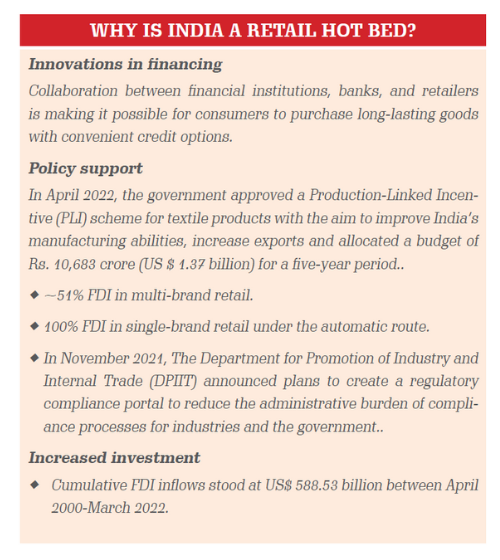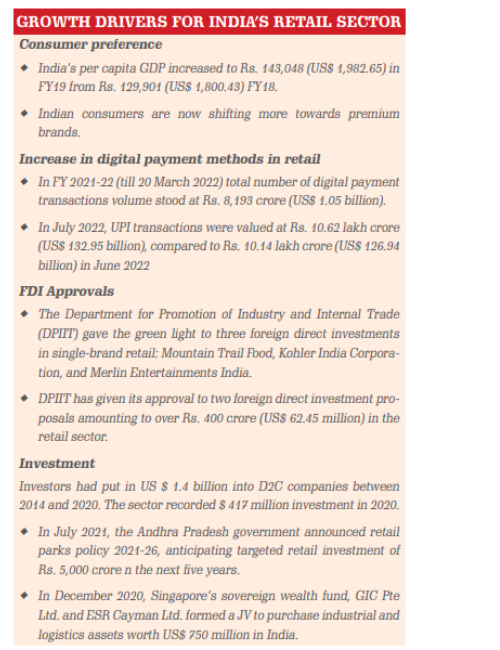Vision for India's Retail Sector

Retail
100 week ago — 14 min read
Three after the world was hit by the COVID-19 pandemic, we can say that things are starting to get back to normal in the retail sector. The retail industry from what we understood from experts speaking at the recently concluded Kolkata Retail Summit (KRS) and Retail India Summit and Expo (RISE) that were held in Kolkata and New Delhi respectively, has moved on, and is now looking ahead.
Several retailers have also openly spoken about the need to stay ahead of the curve when it comes to customer experience (CX) - a key topic that will be discussed in 2023 and beyond.
How has India’s retail performed?
India’s retail industry witnessed a 19 per cent sales growth in the period between April and November 2022 when compared to same pre-pandemic period in 2019, a report by the Retailers Association of India (RAI) has revealed. The eastern part of the country saw a 21 per cent growth compared to 2019, while the north saw a 19 per cent growth. Both western and southern parts of India witnessed an 18 per cent growth during the period, when compared to 2019, the report added.
The industries that did particularly well during this period were the QSR (quick service restaurant) and the footwear industries, with a 30 per cent growth compared to 2019, while the beauty, wellness and personal care industry only saw a 7 per cent growth compared to the numbers that came out in 2019.
Several industry leaders shared their insights during the past six months at RAI-organised summits in Kolkata and New Delhi, and the one thing that stood out when it came to the increase in sales was the fact that many of them had gone back to basics i.e. understanding the customer behaviour and growth. Along with the basics, they added, was a need to adapt to the omnichannel route, which would be a longdrawn-out process, given India’s demographics.

While speaking about the trend, RAI CEO Kumar Rajagopalan said, “Consumers are back to shopping in stores, and it’s something they enjoy even as they continue to buy online. However, while buying online, we must keep in mind that there is a need for trusted brands as customers now only want to buy from reliable sellers.”
RAI Chairman Bijou Kurien also shared his thoughts. “In the last 2 years, we have witnessed dramatic changes in the Indian retail industry. Adoption of technology by offline retailers saw a quantum jump. Online retailers continued to make inroads. SAAS-based technology interventions allowed retailers to augment their customer experience, refine operating processes and gain insights about customers and products through analytics and AI. Customers transformed to adopt newer technologies.
While talking about what to expect in the next year, Kumar Rajagopalan added, “Retail in India is expected to grow better than all other key markets across the world. Omnichannel retail has become the norm for retailers. Concepts like ONDC (Open Network for Digital Commerce) will enable millions of small retailers to participate in digital commerce. However, the coronavirus worry still looms large in other countries and inflation creates headwinds for retail. Having said that, the occasion-wear market (festivals, weddings, etc.) will thrive in the country if no COVID-19 restrictions are introduced,” he said.
Also read: Automation & Streamlining Processes Are Key for Retail Industry to Thrive
Things to Focus On For the Future
Evolving Customer Experience (CX)
Customer experience in the retail industry refers to the overall interaction that a customer has with a company, including all the various touchpoints the customer has with the company, such as visiting a store, browsing a website, interacting with customer service, and so on. It is concerned with the way that a company treats its customers and how well it meets their needs and expectations. Good customer experience in the retail industry can lead to increased customer satisfaction, loyalty, and advocacy, which can ultimately drive business success. Poor customer experience, on the other hand, can lead to customer churn and negative word-of-mouth, which can harm a company’s reputation and bottom line.
To create a positive customer experience, retailers need to focus on providing excellent customer service, having a clear and easy-touse website, offering a wide range of high-quality products and services, and ensuring that the overall shopping experience is enjoyable and convenient for the customer. This may involve investing in technology, training employees, and continuously gathering feedback and insights from customers to understand their needs and preferences.
There are many factors that can contribute to a great customer experience in the retail industry. As Kumar Rajagopalan, CEO at Retailers Association of India points out, Retail has to follow the PAFE model. PAFE stands for Personalised, Accurate, Fast and Everywhere. However, there are also other factors when it comes to keeping costumer experience in mind. These include:
- Convenience: Customers value convenience, so companies that make it easy for them to shop, whether it’s through online shopping, in-store pickup, or other options, are likely to create a positive customer experience.
- Product and service quality: Customers want high-quality products and services that meet their needs and expectations. Companies that consistently deliver on this will create a positive customer experience.
- Personalisation: Customers appreciate when companies take the time to understand their individual needs and preferences and tailor their products, services, and communications accordingly.
- Speed: Customers want quick and efficient service, whether they are shopping in-store or online. Companies that can deliver on this will create a positive customer experience.
- Customer service: Companies that provide excellent customer service, whether it’s through instore interactions, phone support, or online chat, can create a positive customer experience.
- Product selection: Customers appreciate a wide selection of products and services that meet their needs and preferences. Companies that offer a broad range of products are more likely to create a positive customer experience.
- Value for money: Customers want to feel like they are getting a good deal, so companies that offer competitive pricing and promotions are more likely to create a positive customer experience.
Stick to basics, say retailers
The future of retail is to move back to basics – or forward with basics, said several retailers at Kolkata and Delhi. However, they did agree that the omnichannel experience was a natural extension, given that the future customers would be individuals who are only used to browsing online.
The other thing retailers need to rethink is selling their brand, and not a commodity. By selling a brand, the retailers connect with the customer and come with a specific point of view.

The role of malls has also changed. The good news is that malls aren’t a threat to ecommerce, as a report from India pointed out. In 2022, retail space for malls expanded by 10 million square feet, according to a study conducted by ANAROCK. India is expected to open 15 new malls across 12 cities this year.
Mall owners are aware that they can’t complete with giants such as Amazon and Flipkart. Instead, they focus on the mall design and ensure that it gives the customer the best family experience.
Malls can thank the pandemic for this growth. Between 2020 and 2021, when the world witnessed a lockdown, people struggled to step outside the house. However, once curbs were lifted, a lot of people set out in troves to meet friends, family, and loved ones in neutral spaces. Shopping, too, increased, in what retailers and experts are calling ‘revenge buying’. Mall owners are also aware that they can’t complete with giants such as Amazon and Flipkart. Instead, they focus on the mall design and ensure that it gives the customer the best family experience. Today’s malls are designed to the tee that there is also a say about which brand has its store in which part of the mall. The other key aspect of the mall, which ecommerce cannot provide is the food court, which brings in the most footfalls to the mall.
Shopping will slowly become an experience
One of the key elements of experiential retail is interactivity. This can take many forms, such as product demonstrations, hands-on workshops, and interactive displays. For example, a store that sells kitchen appliances might offer cooking classes or demonstrations on how to use their products. This allows customers to see the products in action and get a better understanding of their features and benefits.
Another element of experiential retail is the creation of a themed atmosphere or setting. This might include decorating the store with a particular theme or offering special events or activities that are related to the store’s products or brand. For example, a store that sells outdoor gear might create a wilderness-themed atmosphere and offer guided hikes or other outdoor activities for customers.
Overall, experiential retail is an effective way for retailers to differentiate themselves from the competition and create a memorable shopping experience for customers. By offering interactive and immersive experiences, retailers can encourage customers to spend more time in their stores, which can ultimately lead to increased sales and customer loyalty.
There is a growing interest in the potential for the metaverse to be used as a platform for retail, as it allows for immersive and interactive shopping experiences. Companies are experimenting with creating virtual storefronts and offering virtual products and services within the metaverse. It is still an emerging area, and it remains to be seen how it will develop and how it will impact traditional retail.
ONDC
The Open Network for Digital Commerce (ONDC) will be a massive game-changer for India’s retail industry in 2023. The reasons for this are as follows:
- Will create new opportunities and remove monopolistic environments.
- Will digitise the entire value chain, standardise operations, promote inclusion of suppliers, derive efficiencies in logistics, and enhance value for consumers.
- Will empower merchants and consumers by breaking silos to form a single network to drive innovation and scale, transforming all businesses from retail goods, food to mobility.
The future and the metaverse
There are a variety of ways that companies are experimenting with creating virtual storefronts in the metaverse. Some examples include:
- Virtual Reality (VR) Shopping: VR technology allows users to immerse themselves in a virtual environment, and companies are using this to create virtual storefronts that customers can visit and explore. Customers can browse and purchase products as they would in a physical store, but in a virtual setting.
- Augmented Reality (AR) Shopping: AR technology allows users to superimpose digital content on the real world, and companies are using this to create virtual storefronts that customers can access through their smartphones or tablets. Customers can view and interact with virtual products as if they were physically present in the same location.
- Online Multiplayer Games: Some online multiplayer games have in-game economies, where players can buy and sell virtual items and services. Companies are starting to experiment with creating virtual storefronts within these games, allowing players to purchase real-world products and services while they are playing.
- Social Media Platforms: Some social media platforms, such as Facebook and Instagram, have begun to offer virtual storefronts that businesses can use to sell their products and services to users. Customers can browse and purchase products directly within the app, without having to visit a separate website.
It is still an emerging area, and it is likely that companies will continue to experiment with different ways of creating virtual storefronts in the metaverse as the technology and infrastructure for the metaverse evolves.
At GlobalLinker we believe that every small business has a big potential. Build your store using our pre-created catalogues.
Article source: STOrai Magazine
Image source: Canva
Disclaimer: The views and opinions expressed in this article are those of the author and do not necessarily reflect the views, official policy or position of GlobalLinker.
View STOrai 's profile
Other articles written by STOrai Magazine
The Art & Science of People Pleasing in Retail
11 week ago
Most read this week
Trending
Ecommerce 1 week ago













Comments
Share this content
Please login or Register to join the discussion